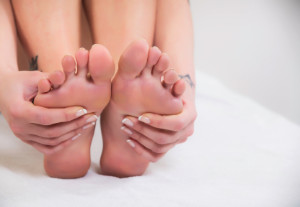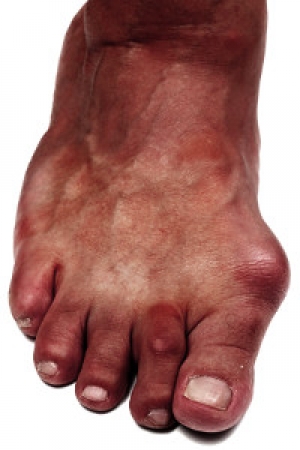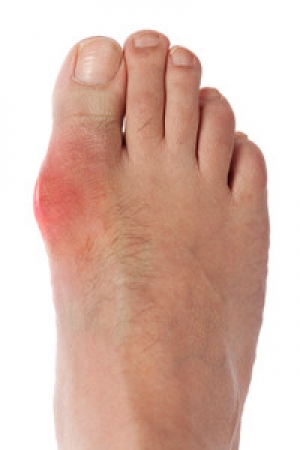Super User
Is Morton’s Neuroma Painful?
 A condition referred to as Morton’s neuroma generally causes severe pain on the ball of the foot or between the toes. The plantar nerve undergoes degeneration and as a result, it becomes thickened and inflamed. Women are more prone to acquire this condition because of the stress and pressure endured by the feet, which is generally caused by the type of footwear that is worn. The symptoms of this ailment typically consist of pain that is experienced between the third and fourth toes or on the bottom of the feet. The pain will often follow a feeling of numbness or tingling and may increase during intense activities. Treatment may consist of incorporating lifestyle changes, including choosing to wear shoes that fit correctly and avoiding any extreme and excessive activities. Please consider scheduling a consultation with a podiatrist for a proper diagnosis and to learn about the best treatment options for you, which may include surgery.
A condition referred to as Morton’s neuroma generally causes severe pain on the ball of the foot or between the toes. The plantar nerve undergoes degeneration and as a result, it becomes thickened and inflamed. Women are more prone to acquire this condition because of the stress and pressure endured by the feet, which is generally caused by the type of footwear that is worn. The symptoms of this ailment typically consist of pain that is experienced between the third and fourth toes or on the bottom of the feet. The pain will often follow a feeling of numbness or tingling and may increase during intense activities. Treatment may consist of incorporating lifestyle changes, including choosing to wear shoes that fit correctly and avoiding any extreme and excessive activities. Please consider scheduling a consultation with a podiatrist for a proper diagnosis and to learn about the best treatment options for you, which may include surgery.
Morton’s neuroma is a very uncomfortable condition to live with. If you think you have Morton’s neuroma, contact one of our podiatrists of Westside Podiatry Center, LLP. Our doctors will attend to all of your foot care needs and answer any of your related questions.
Morton’s Neuroma
Morton's neuroma is a painful foot condition that commonly affects the areas between the second and third or third and fourth toe, although other areas of the foot are also susceptible. Morton’s neuroma is caused by an inflamed nerve in the foot that is being squeezed and aggravated by surrounding bones.
What Increases the Chances of Having Morton’s Neuroma?
- Ill-fitting high heels or shoes that add pressure to the toe or foot
- Jogging, running or any sport that involves constant impact to the foot
- Flat feet, bunions, and any other foot deformities
Morton’s neuroma is a very treatable condition. Orthotics and shoe inserts can often be used to alleviate the pain on the forefront of the feet. In more severe cases, corticosteroids can also be prescribed. In order to figure out the best treatment for your neuroma, it’s recommended to seek the care of a podiatrist who can diagnose your condition and provide different treatment options.
If you have any questions, please feel free to contact one of our offices located in Liverpool, Camillus, Skaneateles, Oswego, and Cicero, NY . We offer the newest diagnostic and treatment technologies for all your foot care needs.
Morton's Neuroma
Morton's Neuroma, also called Intermetatarsal Neuroma or Plantar Neuroma, is a condition that affects the nerves of the feet, usually the area between the third and fourth toe. Neuroma refers to a benign growth that can occur in different parts of the body. Morton's Neuroma strictly affects the feet. This condition causes the tissue around the nerves that lead to the toes becoming thick, causing pain in the ball of the foot.
This condition can be caused by injury, pressure or irritation. Normally no lump will be felt, but instead burning pain in the ball of the foot will be experienced. Numbness and tingling may also occur. With the onset of this condition, a person may feel pain when tight or narrow shoes are worn. As the condition worsens, the pain may persist for days, or even weeks.
Persistent foot pain should always be a concern. The foot should be examined by a podiatrist if pain persists longer than a few days with no relief from changing shoes. The earlier the foot is examined and treated, the less chance there will be for surgical treatment.
There are some factors that can play a role in the development of Morton's Neuroma. These include wearing ill-fitting shoes that cause pressure to the toes, such as high heels. Also, high impact exercise may contribute to the cause of this condition. Morton’s Neuroma may also develop if the foot sustains an injury. Another cause includes walking abnormally due to bunions or flat feet. This causes excessive pressure and irritates the tissue. At times, people are affected for no determinable reason.
Podiatrists can alleviate the effects of this condition using a treatment plan to help decrease the pain and heal the foot tissue. Depending upon the severity of the Morton's Neuroma, the treatment plan can vary. For cases that are mild to moderate, treatments may include applying padding to the arch to relieve pressure from the nerve and reduce compression while walking. Ice packs can also help reduce swelling. The podiatrist may also create a custom orthotic device to support the foot and reduce compression and pressure on the affected nerve. The doctor will probably advise against partaking in activities that cause constant pressure on the affected area. They may provide wider shoes to ease the pressure from the toes. If these treatments do not relieve the symptoms of this condition, the doctor may use injection therapy.
Surgical treatment may be recommended by the podiatrist if all other treatments fail to provide relief. Normally, the podiatric surgeon will decide on either a surgical procedure that involves removal of the affected nerve or will choose surgery to release the nerve. After examination, the surgeon will decide on the best approach to treat the problem.
Recovery varies according to the type of surgical procedure. The patient will also be instructed on the best shoe wear to prevent the return of this condition, along with changes to workout routines, if this was a cause. Preventative measures are important in ensuring the condition does not return.
What are the Benefits of Pursuing a Podiatric Career?
 For those individuals who decide to pursue a career in podiatry, they are most likely aware of the many advantages this field may offer. Recent research has shown that state of the art technology is frequently used to perform precise procedures. This has become necessary in properly responding to the high demand of patients who have specific foot conditions. An additional advantage of choosing this profession may be the flexible work hours, which may be beneficial if a podiatrist decides to become self-employed. Certain disadvantages that exist may include working with feet that have an unpleasant odor. Additionally, many new graduates realize that aggressive networking is recommended to ensure a steady influx of patients. It is suggested to speak with a podiatrist if you are considering pursuing a career in podiatry.
For those individuals who decide to pursue a career in podiatry, they are most likely aware of the many advantages this field may offer. Recent research has shown that state of the art technology is frequently used to perform precise procedures. This has become necessary in properly responding to the high demand of patients who have specific foot conditions. An additional advantage of choosing this profession may be the flexible work hours, which may be beneficial if a podiatrist decides to become self-employed. Certain disadvantages that exist may include working with feet that have an unpleasant odor. Additionally, many new graduates realize that aggressive networking is recommended to ensure a steady influx of patients. It is suggested to speak with a podiatrist if you are considering pursuing a career in podiatry.
If you are dealing with pain in your feet and ankles, you may want to seek help from a podiatrist. Feel free to contact one of our podiatrists from Westside Podiatry Center, LLP. Our doctors can provide the care you need to keep you pain-free and on your feet.
What Is a Podiatrist?
A podiatrist is a doctor of podiatric medicine who diagnoses and treats conditions of the foot, ankle, and related structures of the leg. Your podiatrist may specialize in a certain field such as sports medicine, wound care, pediatrics, and diabetic care. Podiatrists have the ability to become board certified through training, clinical experience, and then taking an exam.
What Do Podiatrists Do?
On a daily basis, a podiatrist may perform the following activities:
- Diagnose foot ailments such as ulcers, tumors, fractures, etc.
- Use innovative methods to treat conditions
- Use corrective orthotics, casts, and strappings to correct deformities
- Correct walking patterns and balance
- Provide individual consultations to patients
It is very important that you take care of your feet. It’s easy to take having healthy feet for granted, however foot problems tend to be among the most common health conditions. Podiatrists can help diagnose and treat a variety of feet related conditions, so it is crucial that you visit one if you need assistance.
If you have any questions please feel free to contact one of our offices located in Liverpool, Camillus, Skaneateles, Oswego, and Cicero, NY . We offer the newest diagnostic and treatment technologies for all your foot and ankle needs.
What is a Podiatrist?
A podiatrist is a Doctor of Podiatric Medicine who treats the foot, ankle, and related structures of the leg. If you are having any pain, injuries, or abnormalities in these areas, it is best that you seek help from a podiatrist.
Podiatrists complete four years of training in a podiatric medical school. Their training is like that of other physicians, and they may go on to complete a fellowship training after a residency training. Some podiatrists are board certified meaning they have advanced training, clinical experience, and have taken an exam to prove their skills. Certifying boards for podiatry are the American Board of Foot and Ankle Surgery and the American Board of Podiatric Medicine. Podiatrists may work in private practices, hospitals, clinics, or they may even become professors at colleges of podiatric medicine.
While in college, those who want to be podiatrists often take biology, chemistry, and physics classes in preparation for podiatry school. In podiatry school, students study how the bones, nerves, and muscles work together to help you move around. Additionally, they study injuries and how to properly diagnose and treat them. Admittance into podiatric medical school requires the completion of 90 semester hours of undergraduate study with a good grade point average, and acceptable scores on the MCAT (Medical College Admission Test)
Podiatrists treat many different conditions such as: aching feet, ankle pain, bunions, corns, hammertoes, fungus, ingrown toenails, plantar fasciitis, sprains and more. Common forms of treatment for these conditions are physical therapy, drugs, or surgery. Podiatrists may also recommend corrective shoe inserts, custom-made shoes, plaster casts, and strappings to correct deformities.
Even if you are someone whose feet are in generally good condition, you should still visit a podiatrist to have your feet properly exfoliated and maintained, or to make sure you are looking after your feet properly.
Helpful Tips for Proper Foot Care
 Foot care is considered to be an essential part of one’s overall well-being, so it is crucial that you take precautions to care of your feet. Perhaps the most important tip to follow is to never ignore pain in your feet. As soon as you notice a substantial amount of pain in either of your feet, you should immediately contact your podiatrist. Another tip is to perform daily foot inspections, so you will be able to treat any issues before they progressively become worse. Additionally, it is important to practice proper hygiene and to wash your feet on a daily basis to ensure that you are not exposing yourself to harmful bacteria. The way you trim your toenails has an influence on whether or not you will develop painful ingrown toenails. The best way to trim your nails is to trim them straight across instead of in a rounded shape. For diabetics, it is especially important that you take care of your feet, because these ordinary foot conditions can easily become more serious.
Foot care is considered to be an essential part of one’s overall well-being, so it is crucial that you take precautions to care of your feet. Perhaps the most important tip to follow is to never ignore pain in your feet. As soon as you notice a substantial amount of pain in either of your feet, you should immediately contact your podiatrist. Another tip is to perform daily foot inspections, so you will be able to treat any issues before they progressively become worse. Additionally, it is important to practice proper hygiene and to wash your feet on a daily basis to ensure that you are not exposing yourself to harmful bacteria. The way you trim your toenails has an influence on whether or not you will develop painful ingrown toenails. The best way to trim your nails is to trim them straight across instead of in a rounded shape. For diabetics, it is especially important that you take care of your feet, because these ordinary foot conditions can easily become more serious.
Everyday foot care is very important to prevent infection and other foot ailments. If you need your feet checked, contact one of our podiatrists from Westside Podiatry Center, LLP. Our doctors can provide the care you need to keep you pain-free and on your feet.
Everyday Foot Care
Often, people take care of their bodies, face and hair more so than they do for their feet. But the feet are a very important aspect of our bodies, and one that we should pay more attention to. Without our feet, we would not be able to perform most daily tasks.
It is best to check your feet regularly to make sure there are no new bruises or cuts that you may not have noticed before. For dry feet, moisturizer can easily be a remedy and can be applied as often as necessary to the affected areas. Wearing shoes that fit well can also help you maintain good foot health, as well as making it easier to walk and do daily activities without the stress or pain of ill-fitting shoes, high heels, or even flip flops. Wearing clean socks with closed shoes is important to ensure that sweat and bacteria do not accumulate within the shoe. Clean socks help to prevent Athlete’s foot, fungi problems, bad odors, and can absorb sweat.
If you have any questions please feel free to contact one of our offices located in Liverpool, Camillus, Skaneateles, Oswego, and Cicero, NY . We offer the newest diagnostic and treatment technologies for all your foot and ankle needs.
Everyday Foot Care
Our feet are arguably one of the most important parts of the body. When it comes to health and beauty routines, the feet and toenails are usually ignored. You should always practice proper footcare to avoid any fungal infections or ailments that can not only ruin the appearance of your feet, but also cause pain. Ignoring any foot problems could potentially lead to an expensive doctor’s visit.
The most important step in proper foot care is to wash your feet daily. You should wash them with soap and water. Doing this will cleanse your feet of dirt, sweat and bacteria. It is crucial that you clean between the toes and pat your feet dry with a towel afterward. Your toenails are also an important part of the feet and you may find that they get dirtier in the summer when you wear sandals. It is important that you practice proper toenail care in addition to cleaning the rest of your feet. When trimming your nails, you should always trim straight across instead of in a rounded shape. Trimming in a curved shape may lead to ingrown toenails.
Moisturization is also important for foot care, and you should be moisturizing your feet every day. The best way to prevent dry feet is to rub lotion or petroleum jelly on your clean feet at night and put socks over them. In the morning, your feet should be soft and moisturized.
Another crucial step in proper foot care is to wear the right shoes for whichever activity you are going to partake in. In warmer weather, you should wear shoes that allow your feet to breathe. It is best to avoid shoes such as flip-fops that do not provide arch support. Tight shoes may also be harmful, and they may even cause you to develop bunions.
If you plan on taking a shower in a public area, you should be especially careful, so you do not pick up any fungi. Showers are prone to harboring different types of bacteria and fungi. You should always wear shower shoes or flip flops when walking around in locker rooms and public showers. Avoid sharing shoes with other people because this is another way that fungus may be spread.
If you are experiencing any problems with your feet you should speak with your podiatrist to determine the best method of treatment for you.
Who is Most Likely To Aquire Gout?
 There are a few symptoms that patients may experience that are indicative of a condition referred to as gout. These may include redness and tenderness in addition to swollen joints under the big toe which is often accompanied by severe pain. This occurs as a result of the build up of crystals in the blood, which may form in and around the joints of the foot. This form of arthritis may often make people feel disabled, and simple tasks such as walking up the stairs may prove to be impossible. The causes of gout may include ingesting red meats and shellfish, overindulgence in alcohol, and taking certain medications that may be responsible for the onset of this condition. Research has shown there may be a strong connection between obesity, high blood pressure, diabetics and gout attacks. If you are afflicted with this ailment, please consult with a podiatrist as quickly as possible to determine what the best treatment options are.
There are a few symptoms that patients may experience that are indicative of a condition referred to as gout. These may include redness and tenderness in addition to swollen joints under the big toe which is often accompanied by severe pain. This occurs as a result of the build up of crystals in the blood, which may form in and around the joints of the foot. This form of arthritis may often make people feel disabled, and simple tasks such as walking up the stairs may prove to be impossible. The causes of gout may include ingesting red meats and shellfish, overindulgence in alcohol, and taking certain medications that may be responsible for the onset of this condition. Research has shown there may be a strong connection between obesity, high blood pressure, diabetics and gout attacks. If you are afflicted with this ailment, please consult with a podiatrist as quickly as possible to determine what the best treatment options are.
Gout is a foot condition that requires certain treatment and care. If you are seeking treatment, contact one of our podiatrists from Westside Podiatry Center, LLP. Our doctors will treat your foot and ankle needs.
What Is Gout?
Gout is a type of arthritis caused by a buildup of uric acid in the bloodstream. It often develops in the foot, especially the big toe area, although it can manifest in other parts of the body as well. Gout can make walking and standing very painful and is especially common in diabetics and the obese.
People typically get gout because of a poor diet. Genetic predisposition is also a factor. The children of parents who have had gout frequently have a chance of developing it themselves.
Gout can easily be identified by redness and inflammation of the big toe and the surrounding areas of the foot. Other symptoms include extreme fatigue, joint pain, and running high fevers. Sometimes corticosteroid drugs can be prescribed to treat gout, but the best way to combat this disease is to get more exercise and eat a better diet.
If you have any questions please feel free to contact one of our offices located in Liverpool, Camillus, Skaneateles, Oswego, and Cicero, NY . We offer the newest diagnostic and treatment technologies for all your foot and ankle needs.
Gout
Gout is a form of arthritis that is caused by a buildup of uric acid crystals in the joints. This considered to be one of the most frequently recorded medical illnesses throughout history. Gout occurrences in the US have risen within the past twenty years and the condition now affects 8.3 million people which is 4% of all Americans. Researchers have found that gout affects men more than women and African-American men more than white men.
Symptoms of gout are warmth, swelling, discoloration, and tenderness in the affected joint area. The small joint on the big toe is the most common place for a gout attack to occur.
People who are obese, gain weight excessively, drink alcohol heavily, have high blood pressure, or have abnormal kidney function are more likely to develop gout. Furthermore, certain drugs and diseases are likely to increase levels of uric acid in the joints which eventually leads to gout. You are also more likely to develop gout if you eat a lot of meat and fish.
Many who experience gout attacks will experience repeated attacks over the years. Some people who have gout symptoms, may never have them again, but others may experience them several times a year. If you have gout symptoms throughout the year, you may have recurrent gout. Those who have gout should also be careful about their urate crystals collecting in their urinary tract, because this may lead to kidney stones.
Diagnosis for gout is done by checking the level of uric acid in the joints and blood. Your podiatrist may also prescribe medicine to reduce uric acid buildup in the blood, which will help prevent any gout attacks.
To treat gout, your podiatrist may also prescribe you Anti-inflammatory medication (NSAIDs) which will relieve the pain and swelling of a gout episode and it can also shorten a gout attack. Maintaining a healthy diet is also a proven method to prevent gout attacks.
Foot Pain Keeps Runner from Competing
 A woman who was an avid runner found that she couldn’t continue her long-distance races due to a stabbing pain in her left foot. She quickly discovered that ice and ibuprofen were not enough to heal the pain she was experiencing. This woman also noticed that although her foot was not red, it was swollen and painful. She then opted to have an X-ray and CT scan on her feet to discover what was happening. The X-ray did not show anything that was wrong, however, the CT scan revealed a stress fracture in the bone. After putting her foot in a surgical boot and going through physical therapy, she still experienced pain in her foot. A second CT scan found that the fracture was healed, but the pain still remained. Her doctor was able to find that the cause of her pain was a benign tumor in her thigh, and once it was removed, she began to feel less weak. As time went on, she eventually was able to gain full strength and continue to run half-marathons without experiencing any pain in her feet.
A woman who was an avid runner found that she couldn’t continue her long-distance races due to a stabbing pain in her left foot. She quickly discovered that ice and ibuprofen were not enough to heal the pain she was experiencing. This woman also noticed that although her foot was not red, it was swollen and painful. She then opted to have an X-ray and CT scan on her feet to discover what was happening. The X-ray did not show anything that was wrong, however, the CT scan revealed a stress fracture in the bone. After putting her foot in a surgical boot and going through physical therapy, she still experienced pain in her foot. A second CT scan found that the fracture was healed, but the pain still remained. Her doctor was able to find that the cause of her pain was a benign tumor in her thigh, and once it was removed, she began to feel less weak. As time went on, she eventually was able to gain full strength and continue to run half-marathons without experiencing any pain in her feet.
Foot Pain
Foot pain can be extremely painful and debilitating. If you have a foot pain, consult with one of our podiatrists from Westside Podiatry Center, LLP. Our doctors will assess your condition and provide you with quality foot and ankle treatment.
Causes
Foot pain is a very broad condition that could be caused by one or more ailments. The most common include:
- Bunions
- Hammertoes
- Plantar Fasciitis
- Bone Spurs
- Corns
- Tarsal Tunnel Syndrome
- Ingrown Toenails
- Arthritis (such as Gout, Rheumatoid, and Osteoarthritis)
- Flat Feet
- Injury (from stress fractures, broken toe, foot, ankle, Achilles tendon ruptures, and sprains)
- And more
Diagnosis
To figure out the cause of foot pain, podiatrists utilize several different methods. This can range from simple visual inspections and sensation tests to X-rays and MRI scans. Prior medical history, family medical history, and any recent physical traumatic events will all be taken into consideration for a proper diagnosis.
Treatment
Treatment depends upon the cause of the foot pain. Whether it is resting, staying off the foot, or having surgery; podiatrists have a number of treatment options available for foot pain.
If you have any questions, please feel free to contact one of our offices located in Liverpool, Camillus, Skaneateles, Oswego, and Cicero, NY . We offer the newest diagnostic and treatment technologies for all your foot care needs.
Foot Pain
The feet, being the foundation of the body, carry all of the body’s weight and are therefore prone to experiencing pain and discomfort. If you are experiencing foot pain, it is important to determine where in the foot you are experiencing this pain to help discover the cause of it. While pain can be experienced virtually anywhere in the foot, the most common sites of foot pain are in the heel and ankle.
Heel pain can be due to a multitude of conditions including plantar fasciitis, Achilles tendinitis, and heel spurs. Pain experienced in the ankle can be a sign of an ankle sprain, arthritis, gout, ankle instability, ankle fracture, or nerve compression. In more serious cases, pain in the foot can be a sign of improper alignment or an infection.
Foot pain can be accompanied by symptoms including redness, swelling, stiffness and warmth in the affected area. Whether the pain can be described as sharp or dull depends on the foot condition behind it. It is important to visit your local podiatrist if your foot pain and its accompanying symptoms persist and do not improve over time.
Depending on the location and condition of your foot pain, your podiatrist may prescribe certain treatments. These treatments can include but are not limited to prescription or over-the-counter drugs and medications, certain therapies, cortisone injections, or surgery.
If you are experiencing persistent foot pain, it is important to consult with your foot and ankle doctor to determine the cause and location. He or she will then prescribe the best treatment for you. While milder cases of foot pain may respond well to rest and at-home treatments, more serious cases may take some time to fully recover.





